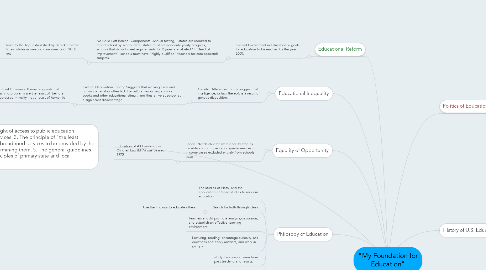
1. The EHA included 6 principles: 1. The right of access to public education programs, 2. The individualization of services, 3. The principle of "the least restrictive environment, 4. The scope of broadened services to be provided by the schools and a set of procedures for determining them, 5. The general guidelines for identifying disability, and 6. The principles of primary state and local responsibilities
1.1. The regular education initiative REI,, which called for mainstreaming children with disabilities into regular classes occurred in the late 1980s
1.1.1. In 1996, the Individuals with Disabilities Act (IDEA) was established.
1.1.1.1. There has been some concern over the amount of students placed in special education classes due to minority status, and of underrepresentation of students who need services, but do not get it.
2. Philosopy of Education
2.1. The studies of Plato, and the application of those studies to modern education.
2.2. Search for truth through ideas
2.2.1. Use the findings to educate others
2.3. Teachers should promote analysis,discussion, and establish an effective teaching environment.
2.4. Lecturing, reading, encourage curiosity, ask questions and apply answers, and work in groups.
2.5. study the classics, learn from past teaching and results,
2.6. assess student successes and weaknesses and apply instruction accordingly.
3. Schools as Organizations
3.1. The Structure of US Education
3.1.1. Governance: While states provide curriculum and standards to school districts, they are carried out by the citizens/tax payers.
3.1.1.1. Size and Degree of Centralization: Schools have been consolidated to save money,yet have a negative impact on diversity.
3.1.1.1.1. Student Composition: School systems are becoming more diverse.
3.2. International Comparisons
3.2.1. Great Britain: more open and less stratified than in earlier years.
3.2.1.1. France:Central government controls the educational system down to the classroom level.
3.2.1.1.1. Russia: Citizens are experimenting with new curricula, privatization, school choice, and philosophies.
3.3. School Processes and School Cultures: schools are separate social organizations.Conflict, Team building, learned new behaviors
3.4. Teachers, Teaching, and Professionalization: Who becomes a teacher,Qualifications,
3.4.1. The nature of teaching: Teachers have to do a lot of role switching, which causes teacher burnout
3.4.1.1. Underqualified
4. Curriculum of Pedagogy
4.1. State Senator District 7: Richard Briggs
4.1.1. District 7 House of Representatives: Marsha Blackburn
4.1.1.1. Tennessee State Superintendent: Dr. Carey Wright
4.1.1.1.1. Giles County Superintendent: J.B. Smith
5. Equality of Opportunity
5.1. Special Needs children were once treated as invisible and not given appropriate services, or in some cases excluded entirely from schools (364)
5.1.1. Education of All Handicapped Children Law (EHA) was passed in 1975
6. Educational Inequality
6.1. Genetic Differences: Some suggest that intelligence, or lack thereof, is a result of genetic disposition.
6.1.1. Cultural Deprivation Theory: Suggests that working class and non-white families often lack the cultural resources, such as books and other educational stimuli, and thus arrive at school at a significant disadvantage.
6.1.1.1. Cultural Difference Theory: suggests that learning problems are the result of being an oppressed minority, not a result of home life
6.1.1.1.1. John Ogbu suggests that African Americans study less, watch more television, and have lower aspirations than their white classmates.
7. Educational Reform
7.1. Federal Involvement in Education: 6 goals for education to be reached by the year 2000.
7.1.1. No Child Left Behind: Components: Annual testing, states are required to report school by school data, states must set adequate yearly progress, schools that do not meet requirements for 2 years are labeled "In Need of Improvement", schools must have "highly qualified" teachers for core academic subjects
7.1.1.1. Race to the Top: established by Barack Obama: to aid states in meeting components of NCLB act
7.1.1.1.1. Charter Schools: public schools that are free from many regulations applied to traditional public schools, but are held accountable for student performance.
8. Politics of Education
8.1. the government should ensure that the same treatment should be applied to all citizens.
8.2. balance the economic stability with the needs of the people in mind.
8.3. government involvement is essential to include all citizens to have a strong national economy
8.4. School systems are not set up to help minorities to become better, more productive citizens.
8.5. Promotes quality with equality to all students
8.6. Traditional vision of education
9. History of U.S. Education
9.1. insisted on government regulation of industry and commerce
9.2. government regulation and conservation of nations national resources
9.3. believed that the result of education was growth, which was firmly posited within a democratic society
9.3.1. John Dewey part of Progressive Movement
9.3.1.1. created the Laboratory School where students could study basic subjects in an integrated curriculum
9.3.1.2. advocated "active" learning
9.4. advocated the creation of a curriculum that would allow for the child's interests and developmental level
9.5. encouraged educators to be socially efficient in how they educated their students
9.6. While in the beginning, people were against public education, by 1860, public support for elementary school was increasing.
9.7. In 1862, Congress passed the Morrill Act, which authorized the use of public money to establish public land grant universities, resulting in the establishment of large state universities (68)
10. Sociological Perspectives
10.1. view society as "a kind of machine, where one part articulates with another to produce the dynamic energy required to make society work(117-18).
10.2. The first to believe in this concept was Emile Durkheim
10.3. Durkheim believed that education was of critical importance in creating moral unity
10.4. consensus is the normal sate in society and conflicts represent a breakdown of shared values.
10.5. students are socialized into appropriate values
10.6. students are sorted and separated according to their abilities
10.6.1. education reform is important to creating programs that encourage social unity.
